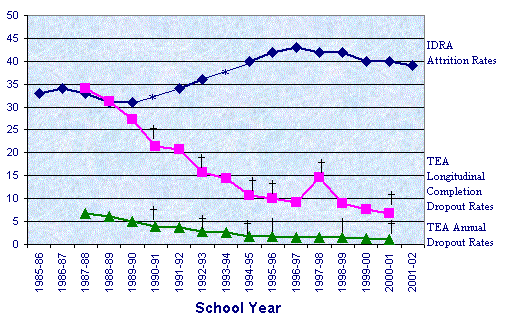• by Roy L. Johnson, M.S. • IDRA Newsletter • October 2002 • 

Is asking schools to graduate 90 percent to 95 percent of their students with a high school diploma too much to ask? Apparently, the highly visible goal of having 90 percent to 95 percent of our public school students remain in school and graduate with a high school diploma has been washed away in the Texas flood waters of questionable dropout statistics, mounting school leaver codes, and vacillating measures of educational excellence.
Research from the Intercultural Development Research Association’s latest attrition study, completed in October 2002, reflects that two of every five students (39 percent) of the freshman (ninth grade) class of 1998-99 left school prior to graduating from a Texas public high school in 2001-02 (see article on attrition).
In contrast, longitudinal completion and school status rates from the Texas Education Agency (TEA) showed that 79.8 percent of students from the class of 2001 graduated with a high school diploma. From 1998 to 2000, the National Center for Education Statistics shows that Texas had a high school completion rate of 79.4 percent. Regardless of the data source, we know that Texas public schools are failing to graduate 90 to 95 percent of their students with a high school diploma.
Since A Nation at Risk was published in 1983, education reform initiatives have targeted improvements in student academic achievement, teaching quality, reduction in the dropout rate, and improvement in the high school completion rates. On the heels of the release of this landmark assessment on the condition of education by the U.S. Department of Education, the Texas Legislature passed House Bill 72, which among other reform efforts increased graduation requirements and established a minimum competency testing program. In 1986, under contract with the Texas Department of Community Affairs and TEA, IDRA conducted the first comprehensive statewide study of school dropouts in Texas.
IDRA estimated that 86,000 students had not graduated from Texas public high schools in 1985-86, costing the state $17.12 billion in foregone income, lost tax revenues and increased criminal justice, welfare, unemployment and job training costs. In 1987, the Texas Legislature adopted HB 1010, which set criteria for collecting and reporting information on students at risk of dropping out of school and for developing a program “to reduce the statewide longitudinal dropout rate to not more than 5 percent of the total student population” (TEC § 11.205).
In 1987-88, a dropout was defined as “a student in grades seven through 12 who does not hold a high school diploma or the equivalent and is absent from school for 30 or more consecutive days” (TEA, 1987). Less than a decade later, in 1994-95, the definition of a dropout was removed from state law and State Board of Education rules. Removal of the statutory language opened the door for subsequent manipulations of state dropout counts.
In 1997-98, TEA began to collect individual student-level records for all school leavers using “leaver codes.” Today, there are 41 such codes. The use of these leaver codes, which often rely on unverified reports of “declared intent to enroll,” has served to severely undercount dropouts.
Amidst the rhetoric by TEA of school accountability and declining dropout rates, the goal of keeping significant percentages of students in school until they graduate with a diploma has been shelved, pigeon-holed or placed on the back-burner by some legislators, state education personnel, district and school personnel, and others.
Concept of School Holding Power
School holding power refers to the ability of schools to keep students in school until they achieve the ultimate objective of a high school diploma. Our current system retains students in grade for failure of the system to assist them in achieving high academic and content standards. But, school holding power shifts the focus from the individual to the schools’ ability to track and support students as they progress through the education system. The ultimate measure then is not to assess whether students fail to navigate the system but how successful schools are in shepherding students from their entry in school all the way through to the point that they receive their high school diploma.
Evidence of Lack of School Holding Power
School holding power is an important indicator of a school’s success (Robledo Montecel, 2003). However, no concerted effort exists to collect or report such data. Lacking a state or national procedure for calculating this measure, dropouts have served as an alternative indicator, reflecting the number and percentages of students that are lost by school systems. Published reports by TEA, NCES, and IDRA show wide disparities in the number and percent of students who are considered dropouts, school completers and graduates.
In 2000-01, TEA reported an annual 1.0 percent dropout rate for students in grades seven through 12 and a 1.4 percent dropout rate for students in grades nine through 12. A reported 17,563 students “officially” dropped out of school at grades seven through 12 and 16,003 at grades nine through 12.
Across race-ethnicity groups at grades seven through 12, TEA reported an annual dropout rate of 1.4 percent for Hispanic students, 1.3 percent for African American students, 0.9 percent for Native American students, 0.5 percent for Asian/Pacific Islander students, and 0.5 percent for White students.
At grades nine through 12, TEA reported annual dropout rates of 2.0 percent for Hispanic students, 1.8 percent for African American students, 1.2 percent for Native American students, 0.7 percent for Asian/Pacific Islander students, and 0.8 percent for White students.
The longitudinal completion and school status rate for the class of 2001 was 6.8 percent for grades seven through 12 and 6.2 percent for grades nine through 12.
NCES is the primary federal entity charged with collecting, analyzing and reporting education data. In the 1991-92 school year, NCES began to collect dropout data through the Common Core of Data (CCD) collection. It works with state education agencies and school districts across the country to develop a national database of public school dropout rates using common data definitions and collection procedures. In 1999-00, 37 states and the District of Columbia submitted data that met the specified definition and collection procedures (see map below for a comparison of NCES dropout rates by state).
Annual Dropout Rates (Grades 9-12), by State
1999-00 School Year


Source: National center for Education Statistics. 1999-00.
Until 1999-00, the Texas dropout counts have not conformed to these standards, and even now the dropout rates calculated by NCES are at least twice those reported by the TEA. For the 1999-00 school year, TEA reported an event (annual) dropout rate of 1.3 percent for grades seven through 12 compared to a NCES reported rate of 3.5 percent (see box below). At grades nine through 12, TEA reported an annual dropout rate of 1.8 percent compared to 5.0 by NCES. NCES reported 35,359 additional dropouts in Texas at grades seven through 12 and 32,951 additional dropouts at grades nine through 12.
The latest attrition study by IDRA for the 2001-02 school year shows that 39 percent of students in the freshman class of 1998-99 left school prior to graduation – 143,175 students were lost from high school enrollment. Across race-ethnicity groups, the attrition rate was 51 percent for Hispanic students, 46 percent for African American students, 29 percent for Native American students, 14 percent for Asian/Pacific Islander students, and 26 percent for White students. A comparison of TEA and IDRA dropout and attrition data are outlined in the box below.
Sources: Intercultural Development Research Association, 2002. Texas Education Agency, Secondary School Completion and Dropouts, 2000-01.
Conclusions
The goal of reducing the dropout rate and the goal of increasing the number and percent of students who graduate from public high schools with a high school diploma must be actualized in Texas. In order to set and assess the accomplishment of these goals, credible dropout data from our state education agency and school districts must become the standard and not the exception. School holding power must become part of our school accountability and success measures.
Is asking schools to graduate 90 to 95 percent of their students with a high school diploma too much to ask? The answer is no. Just as higher and higher standards and expectations are set for our students, the goals of increasing the holding power of our schools and increasing the number and percent of students graduating with a high school diploma must be expected and realized.
Resources
Johnson, R.L. “Missing: Texas Youth – Cost of School Dropouts Escalates,” IDRA Newsletter (San Antonio, Texas: Intercultural Development Research Association, October 2001).
Robledo Montecel, M. “Texas Needs Diplomas, Not Delusions,” testimony before the Texas State Board of Education (San Antonio, Texas: Intercultural Development Research Association, September 12, 2002).
Texas Education Agency. Secondary School Completion and Dropouts in Texas Public Schools: 2000-01 (Austin, Texas: Texas Education Agency, August 2002).
Texas Education Agency. Texas Education Code, Texas Administrative Code and Public Education Information Management System (Austin, Texas: Texas Education Agency, 1987).
U.S. Department of Education, Office of Educational Research and Improvement, National Center for Education Statistics. Documentation to the NCES Common Core of Data, Local Education Agency Universe Dropout File: School Year 1999-00.
Roy L. Johnson, M.S., is the director of the IDRA Division of Evaluation Research. Comments and questions may be directed to them via e-mail at feedback@idra.org.
[©2002, IDRA. This article originally appeared in the October 2002 IDRA Newsletter by the Intercultural Development Research Association. Permission to reproduce this article is granted provided the article is reprinted in its entirety and proper credit is given to IDRA and the author.]



